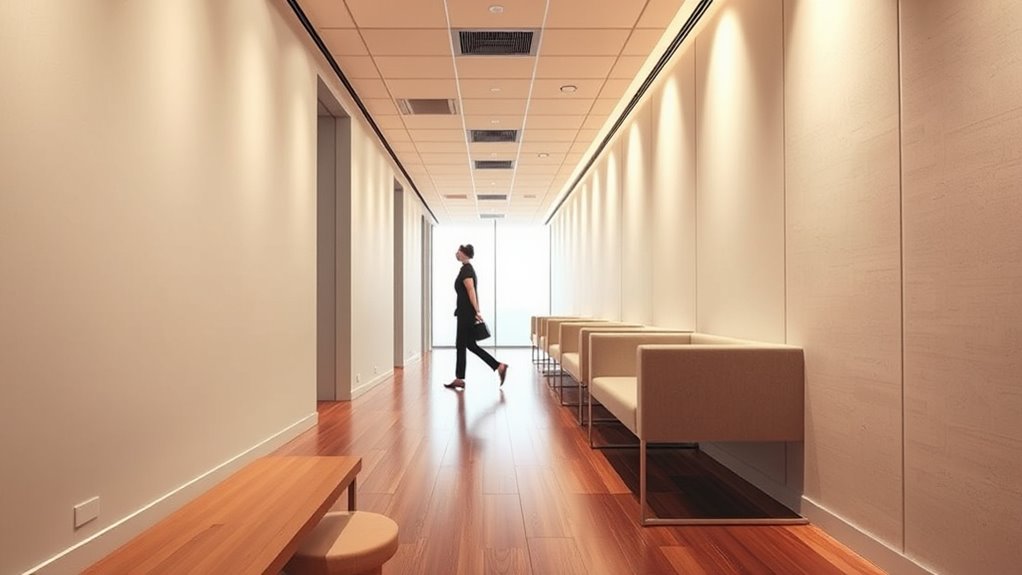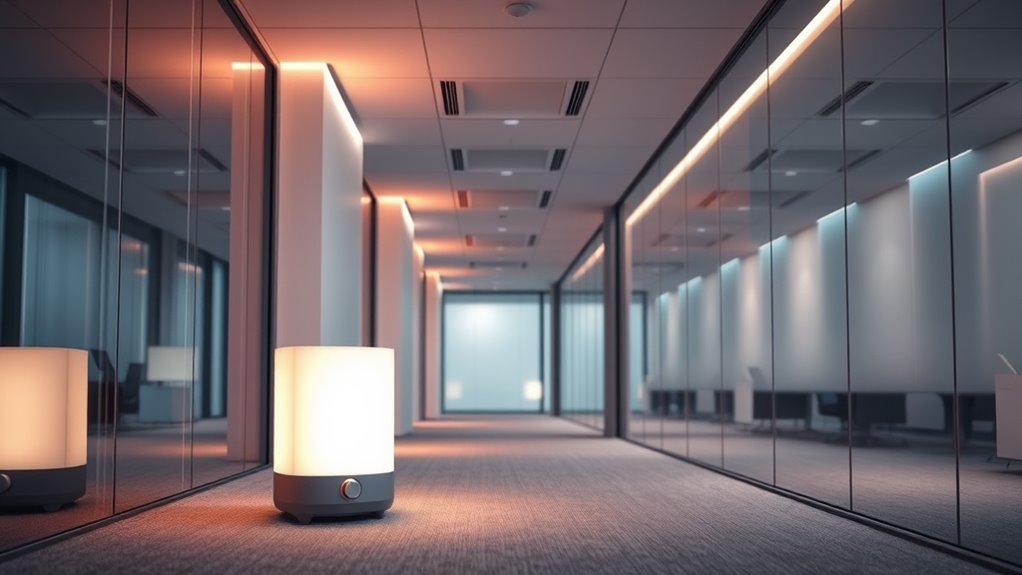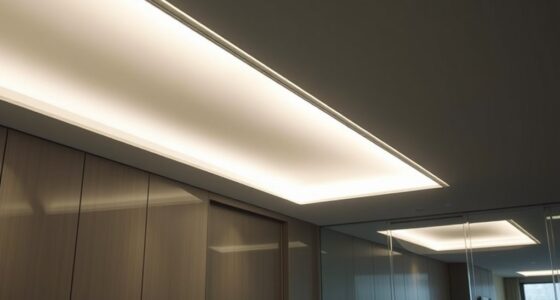To minimize noise footprints in quiet zones, focus on sound discipline strategies like installing effective soundproofing materials and using acoustic design tactics. Sealing gaps around doors and windows, incorporating sound-absorbing panels, and choosing the right materials help reduce sound transmission. Positioning soft furnishings and handling internal surfaces thoughtfully create calm, focused environments. Mastering these techniques builds a naturally quiet space, and exploring further can reveal even more ways to enhance your environment effectively.
Key Takeaways
- Implement soundproofing materials like mass-loaded vinyl and double-glazed windows to block noise transmission effectively.
- Use strategic acoustic treatments, such as panels and soft furnishings, to absorb echoes and reduce internal reverberations.
- Seal gaps around doors and windows to prevent sound leaks and maintain quiet zones.
- Design spatial layouts that position noisy equipment away from quiet areas, optimizing sound behavior within the space.
- Combine soundproofing with acoustic design strategies to create environments with naturally minimized noise footprints.

Have you ever wondered what truly effective discipline looks like? In the context of creating quiet zones within busy environments, it’s about more than just setting rules—it’s about designing spaces that naturally foster calm and focus. That’s where sound discipline comes into play, and it begins with understanding the importance of soundproofing techniques and acoustic design. When you’re aiming to minimize noise footprints, especially in areas designated for concentration or relaxation, these elements become essential tools in your arsenal.
Soundproofing techniques involve using materials and construction methods that block or absorb sound waves, preventing noise from traveling between spaces. Think of adding mass-loaded vinyl barriers, installing double-glazed windows, or using specialized insulation in walls and ceilings. These measures create physical barriers that markedly reduce sound transmission, ensuring that noise from bustling corridors or nearby rooms doesn’t intrude on your quiet zone. Acoustic design, on the other hand, focuses on strategic placement and treatment of surfaces to control sound within a space. Soft furnishings, acoustic panels, and ceiling tiles help absorb unwanted echoes and reverberations, creating a harmonious environment conducive to concentration and calm. When you combine soundproofing techniques with thoughtful acoustic design, you craft an environment where noise is naturally minimized, and focus is naturally enhanced.
Understanding sound behavior within a space can help you identify the most effective areas for applying soundproofing and acoustic treatments, ensuring your quiet zones remain undisturbed. Implementing these strategies requires an understanding of how sound behaves within a space. For example, sealing gaps around doors and windows prevents sound leaks, while positioning sound-absorbing materials in key areas can dramatically improve acoustics. You don’t need to overhaul an entire building to make a difference—small, targeted adjustments can have a profound impact on the overall noise level. When you prioritize sound discipline through these methods, you’re not just reducing noise—you’re fostering a sense of order and control that influences behavior and productivity.
Frequently Asked Questions
How Effective Are Current Noise Reduction Technologies in Quiet Zones?
Current noise reduction technologies are quite effective in quiet zones. Sound masking helps drown out distracting noises, creating a more peaceful environment. Acoustic panels absorb sound waves, reducing reverberation and echo. When combined, these tools markedly improve sound quality, making quiet zones more serene. You’ll notice less noise intrusion and a calmer atmosphere, helping you concentrate and relax. These advancements support your need for a quieter, more comfortable space.
What Are the Legal Regulations Surrounding Noise Levels in Quiet Zones?
Ever wondered how noise levels are controlled in designated quiet zones? You should know that local noise ordinances and zoning regulations set strict limits to protect these peaceful areas. These laws often specify maximum decibel levels and enforce penalties for violations. By adhering to these legal standards, you help maintain the tranquility that quiet zones are meant to provide, ensuring everyone can enjoy the intended peaceful environment without disturbance.
How Can Businesses Balance Noise Control With Employee Communication Needs?
You can balance noise control with employee communication by creating designated quiet zones where noise is minimized, encouraging open communication in designated areas, and using sound-absorbing materials to reduce noise levels. Foster employee engagement by providing tools like headsets or private rooms for focused work. This approach guarantees quiet zones are respected while maintaining open communication channels, enabling your team to stay productive without noise disruptions.
What Are the Best Materials for Sound Absorption in Quiet Environments?
Imagine you’re in a library, where silence is golden. To create such quiet zones, you should use effective sound-absorbing materials. Acoustic panels are excellent for absorbing sound and reducing echo, while soundproof curtains help block external noise. These materials are practical, easy to install, and enhance the tranquility of your space. By choosing the right combination, you guarantee a peaceful environment where focused work and conversations can coexist comfortably.
How Do Noise Footprints Impact Property Value in Quiet Zones?
Your property’s value can decline if noise footprints increase due to noise pollution, especially in quiet zones. Excess noise diminishes the appeal of a location, making it less attractive to potential buyers or tenants. This reduction in desirability can negatively impact your property investment, as lower demand often leads to decreased property prices. Managing noise footprints is essential to preserving your property’s value and maintaining a peaceful, desirable environment.
Conclusion
By embracing sound discipline, you craft a sanctuary where tranquility flourishes, turning noisy chaos into a peaceful oasis. Think of it as planting a delicate seed of quiet in a bustling garden—nurture it carefully, and serenity grows. With mindful noise management, you transform your space into a haven, inviting calm to settle like soft shadows at dusk. Remember, your efforts shape the symphony of silence that others will cherish and follow.



















